Summertime Kickoff Recipes: Grilled Chicken Gyro Lettuce Wraps, cool sides, starters - WISHTV.com |
- Summertime Kickoff Recipes: Grilled Chicken Gyro Lettuce Wraps, cool sides, starters - WISHTV.com
- How to cook the perfect chicken with 40 cloves of garlic – recipe - The Guardian
- Who said chicken is boring? Try these 5 fab recipes - Boston Herald
|
Summertime Kickoff Recipes: Grilled Chicken Gyro Lettuce Wraps, cool sides, starters - WISHTV.com Posted: 26 May 2021 01:55 PM PDT  Are you looking for some healthy Memorial Day Weekend food options? Well, look no further! Michelle Dudash, RDN, registered dietitian, chef and author of the upcoming The Low-Carb Mediterranean Cookbook is helping us kick off the big weekend right with recipes from her new book. CHICKEN GYRO LETTUCE WRAPSIngredients: I love gyros. So why not create a version that we can make at home with chicken? Marinate the chicken overnight for the full-flavor effect. FOR THE CHICKEN:
FOR THE SANDWICH:
Directions:
Suggestions and Variations Gyros can also be made with lamb meat, like loin chops or rump. TOTAL PREP AND COOK TIME: 30 MINUTES, PLUS MARINATING TIME • YIELD: 4 SERVINGS, 1 GYRO EACH PER SERVING: 150 CALORIES, 3 G CARBOHYDRATE (1 G FIBER, 0 G ADDED SUGARS, 2 G NET CARBS), 26 G PROTEIN, 3 G FAT, 280 MG SODIUM. CUCUMBER YOGURT SALADIn my Sithoo's house, leben was as much a staple as ketchup was in other homes. She made it by simmering whole milk until it was "so hot that you couldn't hold your pinky finger in it," as she liked to explain, followed by squeezing the liquid from the curd while wrapped in cheesecloth. I think you will appreciate the shortcut I use in this recipe—head straight for the store-bought Greek yogurt! To make it extra rich and delicious, I use 2% or whole-milk yogurt, rather than nonfat yogurt. Ingredients:
Directions: Combine all of the ingredients in a bowl. You may enjoy the salad immediately or chill until ready to serve, pouring off any liquid. Recipe Note: A hard-core purist would salt the cucumbers first, let them sit for 30 minutes, then pat off the liquid released. That's just not my style. I'm hungry and pretty much want things ready instantly. After pulling the salad from the fridge, however, I will drain off the excess liquid. If you'd like to go the purist route, however, just wait to add more salt to the salad until you've tasted it first. TOTAL PREP AND COOK TIME: 15 MINUTES • YIELD: 5 SERVINGS, 1⁄4 CUP (60 G) EACH PER SERVING: 24 CALORIES, 2 G CARBOHYDRATE (0 G FIBER, 0 G ADDED SUGARS, 2 G NET CARBS), 3 G PROTEIN, 1 G FAT, 242 MG SODIUM. TAHINI SAUCEIngredients:
Directions: To make the tahini sauce: Combine the tahini, water, lemon juice, garlic powder, and salt in a small bowl. ITALIAN-INSPIRED GUACAMOLE WITH BALSAMIC, RED ONION, AND BASILI'm guacamole- and avocado-obsessed like you, most likely. So why not create a guacamole with an Italian twist? Balsamic is an awesome pairing with avocados. A favorite snack of mine during prime-time avocado season is to mash avocado on a cracker and spritz it with balsamic vinegar. Ingredients:
Directions:
Suggestions and Variations: Serve with red bell pepper planks, almond flour crackers, or low-carb chips. Recipe Note:
TOTAL PREP AND COOK TIME: 20 MINUTES • YIELD: 8 SERVINGS, 1⁄4 CUP (70 G) EACH PER SERVING: 108 CALORIES, 7 G CARBOHYDRATE (4 G FIBER, 0 G ADDED SUGARS, 3 G NET CARBS), 2 G PROTEIN, 9 G FAT, 152 MG SODIUM. MEDITERRANEAN QUINOA SALAD WITH AVOCADOI adore quinoa salad, and you can prepare it in limitless varieties. Here is a Greek-themed play on it. Enjoy it as a side salad, or sprinkle cheese, beans, and nuts on top to make it a complete lunch meal. Ingredients:
Directions:
Suggestions and Variations:
TOTAL PREP AND COOK TIME: 30 MINUTES • YIELD: 8 SERVINGS, 1⁄2 CUP (125 G) EACH PER SERVING: 125 CALORIES, 16 G CARBOHYDRATE (3 G FIBER, 0 G ADDED SUGARS, 13 G NET CARBS), 3 G PROTEIN, 6 G FAT, 205 MG SODIUM. BURRATA CHEESE WITH BALSAMIC-MARINATED STRAWBERRIESIf you're a cheese lover, you will fully appreciate the extra creaminess of this Italian cheese, comprised of a mozzarella shell encasing oozy, thick cream. It has so many applications: as an appetizer, plopped on a salad, melted over pasta, and yes, as a final course. Because why not? But try to cut into only the amount of burrata you will use in one sitting, as you will lose the tender consistency over time once the package is open and cheese is cut. In this recipe, I dress up the burrata with marinated strawberries. Make sure you're only using fragrant and sweet strawberries, trimming off any white shoulders. Ingredients:
Directions:
Make It for the Whole Family Even my husband, who usually does not enjoy sweet mixed with savory, loved this dish. However, another substitute for people who like things more traditional is using ripe, quartered cherry tomatoes instead of strawberries. Omit the honey and sprinkle with sea salt. TOTAL PREP AND COOK TIME: 30 MINUTES • YIELD: 4 SERVINGS PER SERVING: 221 CALORIES, 8 G CARBOHYDRATE (2 G FIBER, 3 G ADDED SUGARS, 6 G NET CARBS), 8 G PROTEIN, 18 G FAT, 77 MG SODIUM. By Michelle Dudash, RDN For more from Michelle, visit DishWithDudash.com. |
|
How to cook the perfect chicken with 40 cloves of garlic – recipe - The Guardian Posted: 26 May 2021 04:01 AM PDT Flicking through my parents' copy of Nigel Slater's Real Food as an impressionable teenager, one impossibly daring recipe leapt out: chicken with 40 cloves of garlic may have already been a bit old hat in Nigella Lawson's childhood, but in the provinces, such a quantity still seemed, as Lawson notes, "somehow dangerously excessive". An older colleague at my first summer job always wrinkled her nose if I'd as much as sniffed a clove the night before, so 40 would probably have moved her to tears. (Unsurprisingly, I never plucked up the courage to test her.) The idea is often described as Provençal, though Elizabeth David makes reference to similar dishes from both the Dauphiné, slightly farther north, and the Béarn, in the south-west of France, so, in the absence of firm evidence to the contrary, it seems more than likely that chicken was prepared with large amounts of garlic wherever large quantities of garlic were grown. The elevation of that bulb to star turn seems to have occurred in the US, where in 1954 James Beard published the first recipe calling for the now sacrosanct 40 cloves – which, as Betty Trussell points out, was at that point tantamount to joining the Communist party – and sparked far more than 40 imitations. It pops up in Gourmet magazine, the New York Times and the Silver Palate Cookbook before crossing the Atlantic to find favour with the Galloping Gourmet, Graham Kerr, and Keith Floyd, to name just two. Almost everyone has their own take, and I'm sure they're all delicious, but who does it best? The chicken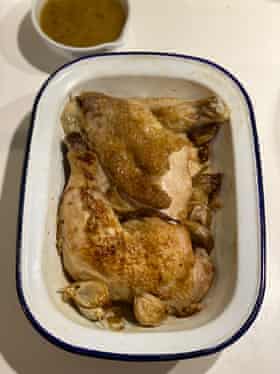 Joyce Goldstein writes in her 1999 book The Mediterranean Kitchen that, "traditionally, this dish is made with a whole roast chicken, baked in a sealed casserole with the garlic cloves and a bouquet garni". However, Beard published a later recipe for a fricassee, and most more recent versions follow his example, with Goldstein explaining that a whole bird would present "portioning problems" in her restaurant (San Francisco's legendary Square One). Chicken pieces do cook more quickly than whole birds, and also do so more evenly, as Cook's Illustrated's New Best Recipe Book points out, plus choosing them also means you can choose your own favourite cut. They're thus perhaps the more sensible choice, but it's said Beard loved the recipe for its theatricality, often demonstrating it on television for that reason, and, to me, that points towards the whole birds used by Caroline Craig in Provence: The Cookbook and Catherine Phipps' book Chicken. (If you're feeding a crowd, or fussy eaters, by all means use chicken joints instead, but you will, in my opinion, miss out on some of the pleasure.) Like Phipps, I'm going to pot roast the chicken to infuse it with garlicky flavour, and to stop the garlic itself from drying out in the heat of the oven, so a brief preliminary sizzle in a hot pan will help offset its inevitable pallor, making it worth the faff of wrestling with a whole bird over a hot stove. Cooks Illustrated brines its chicken pieces briefly before roasting, claiming that it renders the meat "firm, juicy and well seasoned", but as long as you don't overcook the bird, it shouldn't require it. (Note that the 1980s American classic The Silver Palate Cookbook makes this recipe with duck. I haven't tried it, so I can't say whether it's an improvement.) The garlic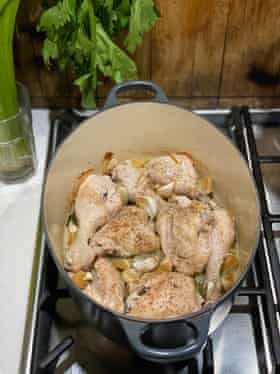 This aspect of things is not, to my mind, afforded sufficient importance in most recipes. It seems likely that this dish was probably originally intended to be made with the fresh spring garlic Craig describes as melting into "ludicrously soft and sweet little parcels" under the bird – Anne Willan notes that "the younger the garlic, the milder the sauce will be". And David quotes Paul-Louis Couchoud that, for success, one requires "heads of garlic from Provence, which have matured quickly and so have not had the time to become too impregnated with their special aroma". (Indeed, with the right garlic, you could even add 100 cloves, as Helen Rosner boldly claims, and not be overwhelmed, except perhaps by the embarrassment of riches.) Fortunately, large heads of fresh garlic aren't hard to come by in early summer, and are certainly the best choice for a dish that, despite its fearsome name, is one of surprisingly gentle, mellow sweetness. However, it's too good to save for a few short months, so if you can't find wet garlic, look for large heads with fewer, more generously proportioned cloves, rather than the small, tightly packed heads that seem to be more common in supermarkets. Not only do I find the latter often have a stronger, more piquant flavour that is not ideal for this dish, but such meanly sized examples will wither during cooking, leaving little or nothing for your sauce. Farmers' markets, greengrocers or continental specialists are good places to look. (If you do find yourself with a few Lilliputian cloves, it's best to copy Phipps and pierce them with a knife, so their flavour can perfume the dish, even if their flesh does not.) 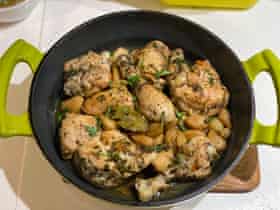 My esteemed predecessor in these pages, Richard Ehrlich, warns that, though there's disagreement over whether or not to peel the garlic before use, one should not do so "under any circumstances". Left intact, he says, the flesh will be "steamed and stewed inside [the] husks" to soft, mild perfection – "the best part of the dish". Puzzlingly, though Beard's original recipe keeps the peel on, the one published on his website removes it, as does Goldstein, who saves time by simmering the cloves in oil before adding them to the chicken, which means that, though deliciously gooey and rich, they don't get much of a chance to mingle with the meat and sauce. The same goes for the Cook's Illustrated garlic, which is baked separately, then added to the pan at the last minute, apparently because they find the stuff in the traditional recipe "spiritless". I respectfully disagree, preferring to cook the garlic with the chicken, so the two can commune in the pot, then squeeze the soft, pulpy flesh into the chicken juices to make a sauce, as in Phipps' version. That said, I love the texture of the slow-cooked cloves, which, as Couchoud says, should be "as tender and sweet as new potatoes", so I'm going to keep some whole to enjoy as a vegetable accompaniment to my garlic-flavoured chicken in garlic sauce. Aromatics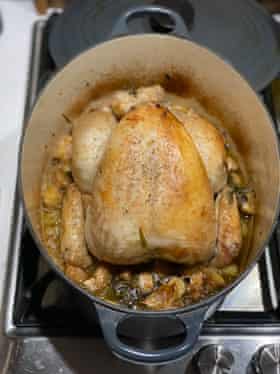 Most people eschew other vegetables, preferring to let the garlic do the talking, but Beard bakes the bird on a bed of onion and celery, while Cooks Illustrated adds shallots, which it says make the sauce "fuller and rounder". All these things work well with the chicken, but they're certainly not necessary for a great-tasting result. The same goes for the herbs that most pop in the pot – sage, rosemary, bay, marjoram, oregano, parsley and tarragon are all attractive possibilities, but, for me, the citrussy, slightly peppery flavour of thyme is the best choice. Do as you wish, however; it's hard to go wrong with any of the above. Interestingly, Beard also adds grated nutmeg. Though, instinctively, this doesn't seem a marriage made in heaven, it actually works very well with the creamy sweetness of the slow-cooked garlic – again, however, this is very much an optional extra. The sauce What pot-roasted chicken may lack in crisp, golden skin, it more than makes up for with gravy. A splash of white wine or dry vermouth is a good base, diluted either with water, or, for a richer, more restaurant-like result, chicken stock to give your bird a helping hand. Phipps suggests finishing the sauce with single cream, and Cooks Illustrated with a knob of butter, both of which are, of course, delicious, especially if you want a more intensely flavoured dish. For a thinner, more rustic gravy, however, just leave things be. Serve with something to soak up all those delicious juices – good bread, new potatoes or rice all spring to mind, with an undressed green salad on the side. Perfect chicken with 40 cloves of garlicPrep 30 min 4 large heads of garlic (wet or standard) Heat the oven to 200C (180C fan)/390F/gas 6. Separate the garlic into individual cloves, discarding the papery outer layer, but otherwise leaving them unpeeled.  Pierce any very small cloves with a sharp knife, then set the lot aside for the time being. Grease a casserole dish that's a little bigger than the chicken itself with olive oil, then put on a high heat.  Season the chicken, then brown it on all sides as best as you can (tongs are useful here), lift it out and set aside, and turn down the heat to medium. Add the garlic and half the thyme to the pot, toss to coat in the fat, and season. Pour in the vermouth (or wine) and stock (or water), then put the chicken on top; put any small garlic cloves, plus the remaining thyme, into the bird's cavity first. 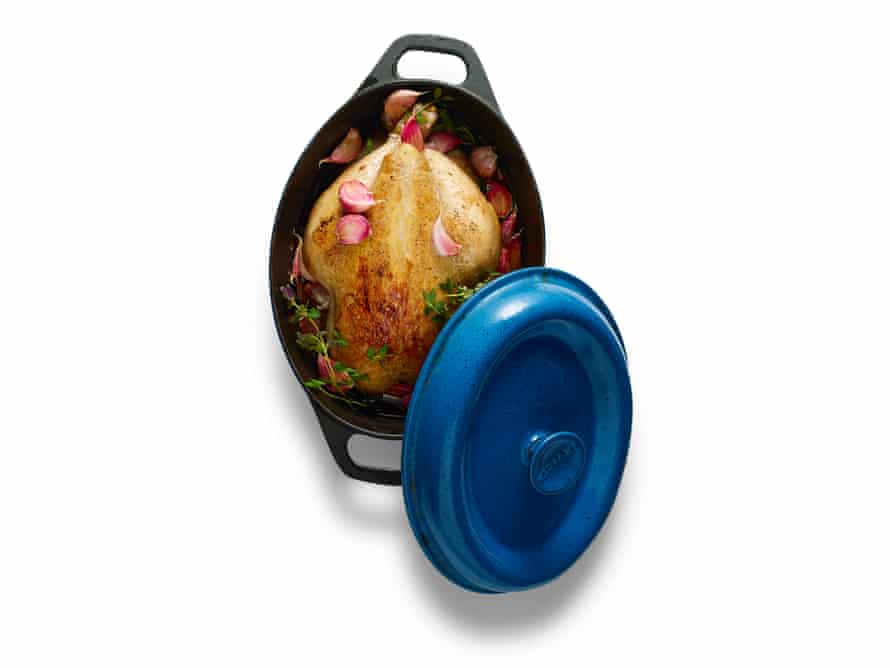 Bring the liquid to a simmer, cover the pot and put in the oven for about 45 minutes. Take off the lid and roast the chicken uncovered for another 15 minutes, to help brown the skin slightly, then check to see if it's cooked through - the juices should run clear from the thickest part of the thigh. If not, return to the oven for a few minutes more. 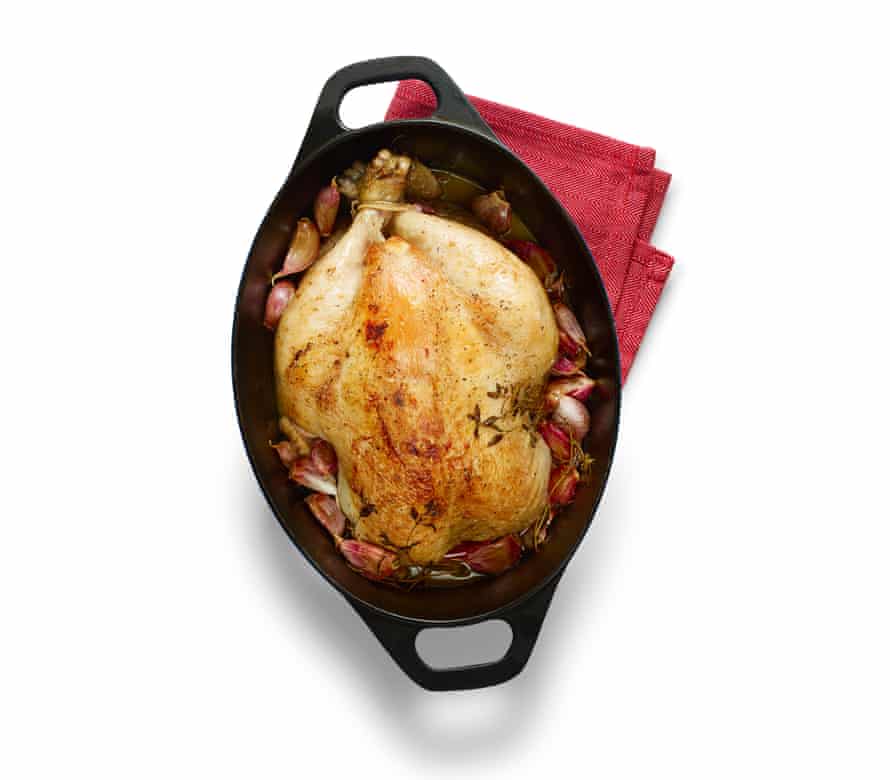 Once the chicken is ready, lift it out of the pot and put it in a warm place to rest. Meanwhile, scoop out the garlic cloves from the sauce with a slotted spoon and set aside to cool slightly. Return the pot to the hob, bring up to a simmer, then bubble until the liquid has reduced by about a third. 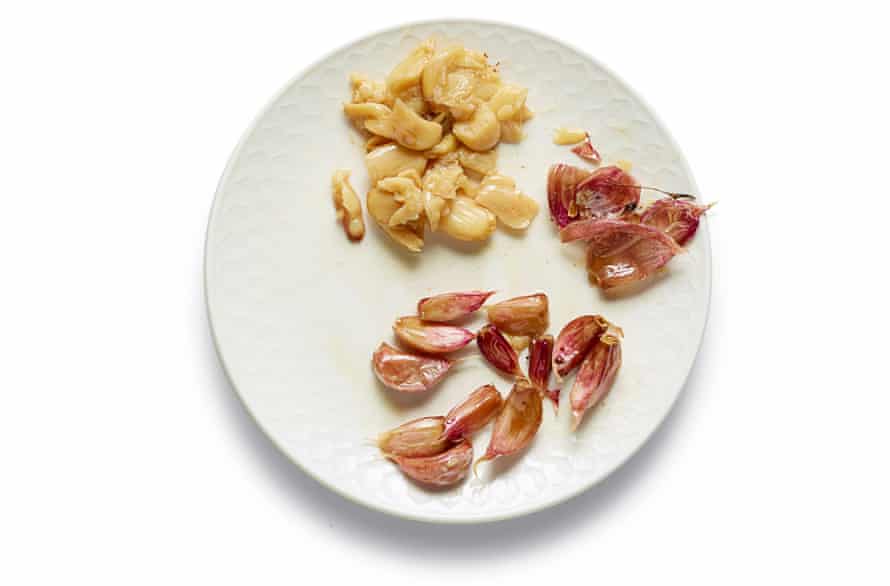 Carefully squeeze out the garlic cloves from their skins and set about half of the plumpest, most handsome ones aside. Mash the rest of the garlic into the sauce, taste for seasoning and adjust as necessary. Transfer the chicken to a platter, surround it with the reserved whole cloves of garlic and serve with the sauce on the side. Chicken with 40 cloves of garlic – is 40 enough, or does the very thought make you shudder? Do you have fond memories of the French version, or remember the dish's heyday over here? And which other mid-century favourites deserve a revival? |
|
Who said chicken is boring? Try these 5 fab recipes - Boston Herald Posted: 19 May 2021 02:02 AM PDT Some people look at chicken and see something boring. Bland. Blah. I look at chicken and see a world of possibilities. I like chicken. I probably make it dozens of different ways. But over the years, five ways for making it have come to the fore, firmly establishing themselves as my favorite methods ever. These are recipes that transform the humble chicken from the ordinary and everyday into a meal of transcendent perfection. That may be overstating it a bit. But these recipes are good. They're really, really good. 
CRISPY-SKIN CHICKEN WITH PAN SAUCE4 small chicken thighs or 2 large thighs Salt and pepper 1/2 c. dry white wine, see note 1/2 c. chicken broth, see note 3 sprigs basil, thyme or tarragon, or 2 sprigs rosemary 1/2 T. butter Note: If you don't want to use wine, use 1 cup chicken broth. With a sharp knife, cut fairly deeply along both sides of the bone on the back of the thighs. Season chicken with salt and pepper and place skin-side down on an unheated skillet. Place skillet on stove and turn heat to medium-high. Cook a few minutes until you see rendered fat emerge from under the meat. Cover and cook until meat is done, 20 to 30 more minutes, depending on the size of the thighs (cut into meat to check; it is done when meat at thickest point is no longer pink). Remove chicken and keep warm. Pour out fat from skillet. Place skillet back over high heat and add wine, if using, broth and herbs. With a wooden spoon, stir up all the brown bits on the bottom. Simmer until liquid is reduced by half or more. Remove pan from heat, add butter, and swirl butter around until it is melted and incorporated into sauce. When serving, place chicken on plate and spoon sauce around it, to keep the skin crispy. Makes 2 servings. (Crispy-skin method by Jacques Pepin; pan sauce recipe by Daniel Neman.) KARAAGE3 T. soy sauce 2 T. sake 1 T. grated fresh ginger 2 garlic cloves, minced 3/4 t. granulated sugar 1/8 t. table salt 1 1/2 lbs. boneless, skinless chicken thighs, trimmed and cut crosswise into 1- to 1 1/2-inch strips, see note 1 1/4 c. cornstarch 1 qt. peanut or vegetable oil, for frying Lemon wedges Note: Do not use chicken breasts, which will dry out during the frying. Combine soy sauce, sake, ginger, garlic, sugar and salt in medium bowl. Add chicken and toss to combine. Let sit at room temperature for 30 minutes. While chicken is marinating, line a rimmed baking sheet with parchment paper. Set wire rack in second rimmed baking sheet and line rack with triple layer of paper towels. Place cornstarch in wide bowl. Lift chicken from marinade, 1 piece at a time, allowing excess marinade to drip back into bowl but leaving any garlic or ginger bits on chicken. Coat chicken with cornstarch, shake off excess and place on parchment-lined sheet. Reserve marinade. Add oil to large Dutch oven until it measures about 3/4-inch deep and heat over medium-high heat to 375 degrees. While oil heats, check chicken pieces for white patches of dry cornstarch. Dip back of spoon in reserved marinade and gently press onto dry spots to lightly moisten. Using tongs, add half of chicken, 1 piece at a time, to oil in single layer. Cook, adjusting burner if necessary, to maintain oil temperature between 300 and 325 degrees, until chicken is golden brown and crispy, 4 to 5 minutes. Using spider skimmer or slotted spoon, transfer chicken to paper towel-lined rack. Return oil to 325 degrees and repeat with remaining chicken. Serve with lemon wedges (the lemon adds an important flavor note). Makes 4 to 6 servings. For even better results, fry a second time at least 1 or 2 hours, and as long as 24 hours, after frying the first time. Keep refrigerated before frying a second time. (Adapted from "The Chicken Bible" by America's Test Kitchen.) 
MAPLE-BOURBON CHICKEN WINGS2/3 c. maple syrup 2/3 c. bourbon 1/4 c. dark brown sugar, firmly packed 1/2 t. crushed red pepper or cayenne pepper, or to taste, optional 3 lbs. chicken wings Preheat oven to 400 degrees. In a small saucepan, mix together maple syrup, bourbon, brown sugar and pepper, if using. Bring to a boil, reduce the heat and simmer until it reaches the thickness of a syrup. You will have about 1 cup of liquid. Allow to cool and thicken. Season wings with salt and pepper. Spread on a baking sheet in a single layer. Roast for 20 minutes. Flip and roast 15 more minutes. Place wings in a bowl and toss with maple-bourbon mixture. Spread coated wings back on baking sheet and cook until done (internal temperature of 165 degrees), 10 to 20 minutes, depending on size of wings. If wings start to get too dark, cover with a sheet of aluminum foil. Makes 4 to 6 servings. (Adapted from "Salt Sugar Smoke" by Diana Henry.) 
ROAST CHICKEN WITH HERBED BUTTER AND CROUTONS4 T. (1/2 stick) butter, slightly softened 1/2 c. chopped fresh herbs, such as flat-leaf parsley, chives, chervil, basil or cilantro 1 t. table salt or fine sea salt 1/2 t. dried garlic flakes 1 whole small chicken, about 3 1/2 lbs. 1 2/3 c. cubed day-old bread Note: The chicken can be buttered and stuffed up to a day in advance, wrapped in plastic wrap and refrigerated. Preheat oven to 450 degrees. In a medium bowl, mash together the butter, herbs, salt and garlic flakes. Put the chicken breast-side up, neck end facing you, on a clean work surface. Slip a clean hand under the skin, starting at the base of the neck, and work your hand further in gently, lifting the skin over each breast and down over each thigh, without tearing. Once the skin is loosened, slip in two-thirds of the herbed butter (reserve the rest for the croutons), pushing it under the skin to coat the breasts and thighs evenly. Add the bread cubes to the remaining herbed butter and stir to coat. Stuff the buttered cubes inside the cavity, and tie the chicken with kitchen string around the drumstick ends and wings to hold its shape. Put the chicken breast-side up in a baking pan, preferably on a rack. Roast for 20 minutes. Loosen the chicken gently from the rack or the bottom of the pan. Flip to expose the back and baste with the juices. Roast for 20 minutes more. Loosen and flip so the breast faces up again, baste with the juices and roast until the skin is golden brown and crackly, a final 20 minutes (longer if the chicken is more than 3 1/2 lbs.). A meat thermometer inserted into the thickest part of the thigh should register 165 degrees. Remove from the oven, cover with foil and let rest 10 to 15 minutes. Carve the chicken and serve with the croutons and cooking juices. Makes 4 servings. (Recipe from "Tasting Paris" by Clotilde Dusoulier.) 
RAO'S FAMOUS LEMON CHICKEN2 c. fresh lemon juice 1 c. olive oil 1 T. red wine vinegar 1 1/2 t. minced garlic 1/2 t. dried oregano Salt and pepper to taste 2 (3 to 3 1/2 lb.) chickens, halved 1/4 c. chopped parsley Preheat oven to 425 degrees. Place racks in top and bottom thirds of oven. Whisk together lemon juice, olive oil, vinegar, garlic, oregano, salt and pepper. Cover and refrigerate if not using within several hours. Whisk or shake vigorously before using. Season chicken halves with salt and pepper, place on 2 baking sheets and roast 30 minutes, turning once. Cook longer if using larger chickens. Remove chicken from oven and preheat broiler. With a very sharp knife, cut each half into 6 pieces (leg, thigh, wing, 3 small breast pieces). Pour sauce over chicken and toss to coat well. If necessary, divide sauce in half and do this in 2 batches. Broil 1 pan of chicken for 3 minutes. Turn each piece and broil for an additional minute. Keep that chicken warm while repeating with the other pan. Place chicken on serving platter or individual plates. Pour sauce into a heavy saucepan. Stir in parsley and place over high heat for 1 minute. Pour sauce over chicken and serve with lots of crusty bread to absorb the sauce. Makes 6 to 8 servings. (Recipe from "Rao's Cookbook" by Frank Pellegrino.) |
| You are subscribed to email updates from "chicken recipes" - Google News. To stop receiving these emails, you may unsubscribe now. |
Email delivery powered by Google |
| Google, 1600 Amphitheatre Parkway, Mountain View, CA 94043, United States | |
from What to Cook https://ift.tt/3vxJjQg
